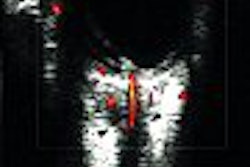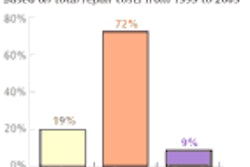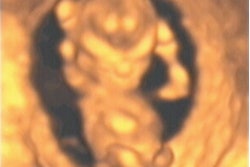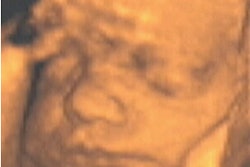PHOENIX - When every clinician can carry his or her own ultrasound unit -- as is rapidly becoming the case in U.S. healthcare -- what will happen to the practice of imaging's notoriously operator-dependent modality?
According to presentations at this week's American Institute of Ultrasound in Medicine (AIUM) meeting, the leaders of this organization aren't waiting to find out. They're taking steps to establish quality standards before the day, predicted for a few years hence, when clinicians have "sonoscopes" slung around their necks like stethoscopes.
For example: Thanks to efforts led by the AIUM and the American College of Radiology, next year's CPT manual will include more detailed descriptions of what constitutes a complete or limited ultrasound examination for purposes of reimbursement.
Essentially, "ff there's no hard copy and no report, there's no bill," said Dr. Robert Bree of Radia Medical Imaging in Everett, WA, moderator of the AIUM's Sunday preconvention course on the practice of ultrasound.
Eliminating reimbursement for undocumented on-the-fly sonography "has the potential of answering some of the questions" raised by compact ultrasound, said Dr. Lennard Greenbaum, co-director of fetal diagnostics at the Arnold Palmer Hospital for Women and Children in Orlando, FL.
"Unfortunately, as we all know, even with ultrasound as it's being practiced today, there's a lot of things we'd like to see improved. I think that dispersing it among a huge, exponentially larger number of physicians is only going to exacerbate the problem," said Greenbaum, who is also president-elect of the AIUM.
While high-end units costing more than $100,000 still make up a majority of ultrasound sales, small systems are already a big factor in the ultrasound market. And because they are cheaper than high-end machines, compact units also appeal to a more diverse range of medical professionals.
Hand-carried ultrasound machines weighing 15 pounds or less made up 22% of the units sold in 2003, according to Klein Biomedical Consultants of New York City. While the overall ultrasound market is growing 5-7% each year, the hand-carried segment is growing 16% or more each year. By 2008, 32% of the ultrasound units sold will be hand-carry size, Klein predicts.
The term "compact ultrasound" is being used to cover an even wider range of products -- including so-called "luggable" units that weigh over 15 pounds but are still designed to be more portable than traditional high-end cart models.
And in the near future, the market will include ultrasound systems small enough for a physician's black bag, or even designed to be draped around the neck like a stethoscope.
At the AIUM Forum on Compact Ultrasound held in April, the vendor consensus was that such sonoscopes were only three to five years away from hitting the market, Greenbaum reported. By 2010, they will make up half of the predicted $1-billion-a-year compact ultrasound market, according to a Frost and Sullivan report.
Such predictions are troubling to Greenbaum, who is particularly concerned about the potential use or misuse of ultrasound in a new fashion, as an adjunct to the physical exam.
"The device that's coming out of a physician's black bag may not be appropriate for doing an ultrasound imaging procedure," said Greenbaum. "There are some very serious problems that could occur by screening with these small devices."
Participants in the April AIUM forum -- which included representatives of 20 diverse organizations including radiologists, sonographers, cardiologists, anesthesiologists, and nephrologists -- agreed that technical specifications should be established for ultrasound uses.
Many also questioned whether the adjunct ultrasound exam should ever be a reimbursable service. "The physician does not get reimbursed for using his stethoscope or his otoscope when he's doing a physical exam," Greenbaum noted, "and would this be any different?"
Conversely, the reimbursement for proper ultrasound services should not be reduced simply because they are performed with a smaller system, Greenbaum said. The AIUM and others have already beaten back an attempt by some local carriers to make such cost-cutting distinctions.
"Regardless of the type of service, there is a need to better define education, training, and competency for those performing and interpreting ultrasound examinations," Greenbaum said, citing the forum's consensus statement.
Even those physicians who aren't among the traditional users of ultrasound want to see standards, Greenbaum said, because they have a vested interest in seeing ultrasound succeed for their specialties.
"My feeling today is that we need to set bars. I don't care what uniform you're wearing, if you can jump over the bar, fine. If you can't jump over the bar, you shouldn't be in the game," Greenbaum said.
Liability concerns will also serve to keep many nonradiologists from significantly increasing their ultrasound interpretations, Greenbaum added.
And as noted by Greenbaum and others at Sunday's presentation, compact ultrasound also holds benefits for radiologists.
For one thing, radiologists are the second biggest purchasers of compact units (after cardiologists), using the systems for bedside services, vascular access, biopsy guidance, and other purposes.
Clinicians with sonoscopes could also create a lot more work for ultrasound radiologists, noted Bree. "They will be going around the hospital, finding things that they have no idea what they are," he said, "and they'll be referring for a real ultrasound."
By Tracie L. ThompsonAuntMinnie.com staff writer
June 21, 2004
Related Reading
Emergency ultrasound training improves, but few ER docs meet AIUM guidelines, March 29, 2004
Frost: U.S. ultrasound market hits $1.26 billion, February 9, 2004
Affordable equipment accelerates ultrasound proliferation, January 26, 2004
Non-radiologists outpace radiologists in skyrocketing use of ultrasound, December 1, 2003
Copyright © 2004 AuntMinnie.com



















